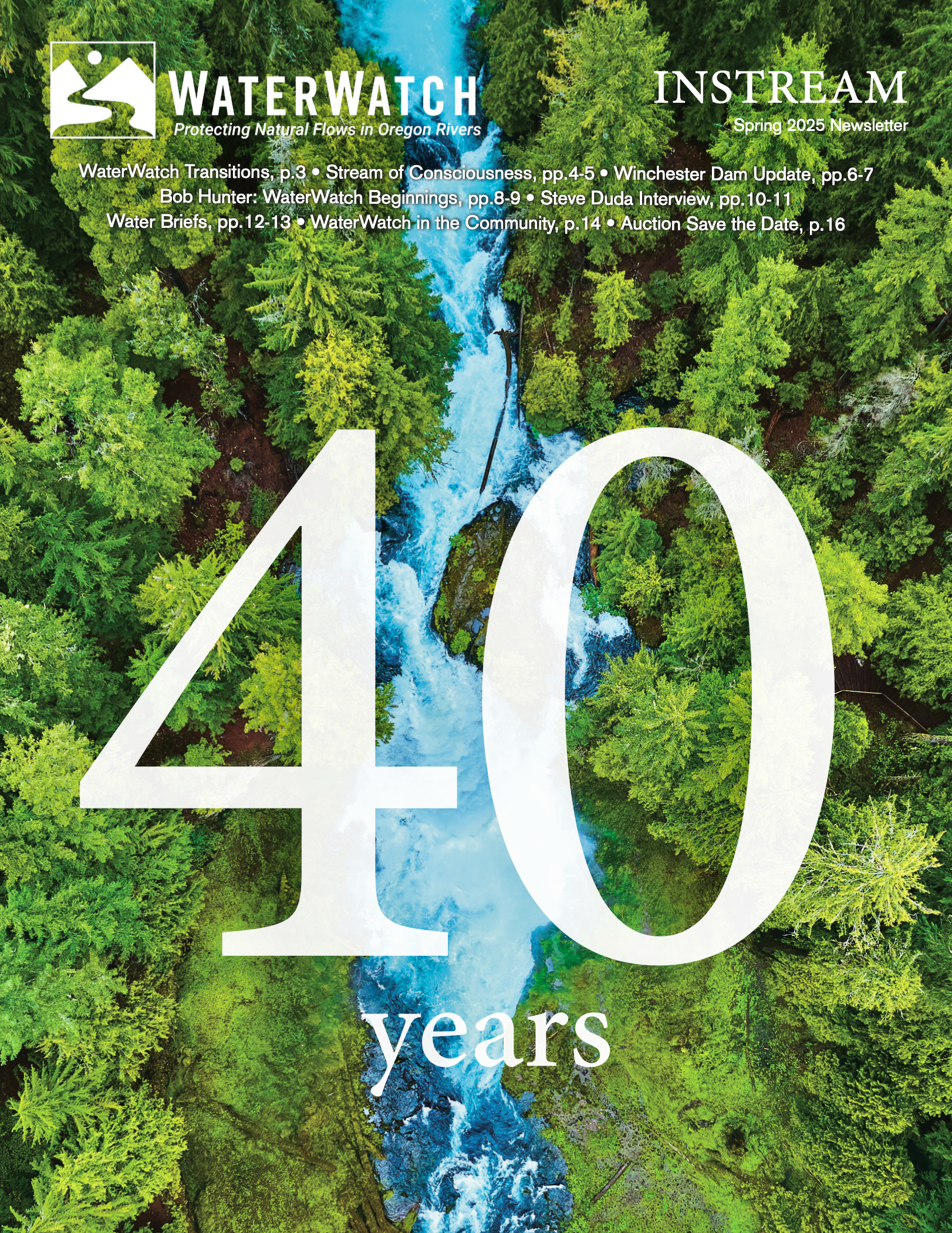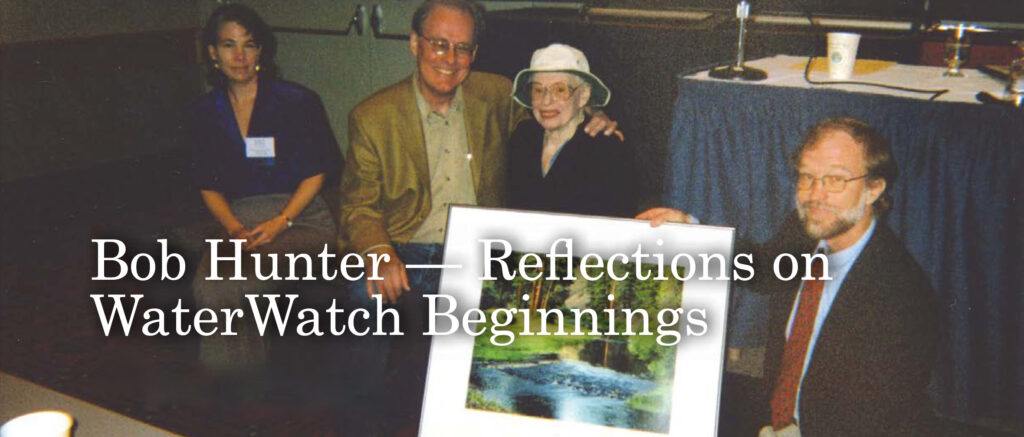By Tommy Hough
One of WaterWatch of Oregon’s founding board members and long-time staff attorney, Bob Hunter participated with WaterWatch’s founders, Tom and Audrey Simmons, in the early discussions leading up to the organization’s establishment. As part of our 40th anniversary archival project, Instream recently spoke with Bob about the early years of WaterWatch, and the years leading up to, and after, the passage of the landmark Instream Water Rights Act in 1987.
“We didn’t have much in the way of membership or any paid staff at first,” said Bob, “we just had Tom and Audrey as volunteer staff, I did some pro bono legal work, and we had an amazing network of lawyers, law professors, water experts, fish experts, legislators, agency folks and conservationists that Tom and Audrey assembled for advice and guidance.”
“People couldn’t resist coming to Audrey and Tom’s Hillsboro home, Horse Heaven, for stimulating discussions on water law and policy, and to indulge in Audrey’s gourmet lunches. I drove up to Hillsboro at least one weekend every month, but for periods when we were getting off the ground or working on legislation it was every weekend.”
It was during these meetings and conversations at Horse Heaven it became clear a statewide organization was necessary to address needed changes to Oregon’s water law and policy. Audrey came up with the name, WaterWatch of Oregon, and the organization was formed in 1985.
“In the early 1980s Tom and I became concerned about Rogue River steelhead and salmon spawning tributaries drying up too early as a result of water diversions, which resulted in greatly reduced fish production,” said Bob.
“We did a thorough review of Oregon’s water code and realized it allowed people to apply for, and get, a water right to divert water out of the stream without any assessment on how the diversions impacted streamflows and fish. A lot of our streams were over-appropriated and in really bad shape as a result, so we started to talk about changes that could be made in the law, and the need to have a law that specifically protected, or provided a mechanism, to ensure protection for streamflows. We started working on the concept of a water right to especially protect water instream.”
“With the formation of WaterWatch and Audrey’s extensive contacts in the state legislature from her work with the League of Women Voters, Tom and I went to work on drafting the instream water right bill. Thanks to Audrey, Tom, and Doug Myers, our lobbyist, and key support from then-Senators John Kitzhaber, Senator Bill Bradbury, and Representative Carl Hosticka, we managed to get the bill introduced and passed. I was president of the Rogue Flyfishers at the time and we managed to get many of the sportfishing organizations in Oregon to support and sign onto the bill. At that time the opposition, i.e. the agricultural industry and other water users associations, weren’t at that time aswatchdiog powerful or well organized.”
According to Bob, the passage of the Instream Water Rights Act was a “game changing” moment. “That was our major legislative kickoff. It was the first major victory and success WaterWatch had, and it was unique throughout the West. Very cutting edge.”
“The other thing that developed around that time was Tom and Audrey attended all the Water Resources Commission meetings. Per the WaterWatch name, the idea was to monitor allocations and decisions and policies of the state agencies that dealt with water resource allocation and management.”
“Having a group of skilled advocates watchdogging water resource agencies, and then influencing those agencies’ allocations and policies and continuing to work not just at the agency level but at the legislative level, watchdogging all the bills that affected water and streamflow was a big deal,” said Bob. “Over time, we also got better and better people onto the Water Resources Commission. In fact, we got a commission that ultimately resulted in the updated groundwater allocation rules last year.”
Bob’s younger brother Dave, then a few years out of Harvard Law School, served as WaterWatch’s first executive director. “We had enough money to pay him for one month. Then we didn’t get some funding we’d hoped for, so Dave wound up working free for an entire year. Charles Wilkinson later helped get us some Ford Foundation money, which was our first multi-year grant.”
“With that, we were able to start hiring staff,” said Bob. “We hired Karen Russell, and she started to look at all water permit applications and became our watchdog. She was diligent. She watched everything the state did, and protested every water right application when there wasn’t a determination of whether or not water was available. Her efforts finally resulted in another one of our early successes when she was able to get the Water Resources Department to develop a policy in which they would run a water availability analysis before issuing a new water right.”
“If water wasn’t available during any month that someone wanted to divert water, that application would be denied. That helped stop the spigot where water rights kept being issued from the department, even if the water wasn’t there and we were just digging a deeper and deeper hole. That was significant.”
“We were also able to bring on Jeff Curtis as the next executive director and he was instrumental in turning WaterWatch into an effective, professional, staff-driven organization with more stable funding.”
According to Bob, another early case that was uncovered as a result of WaterWatch’s watchdogging involved Boeing. “The state had leased thousands of acres to Boeing in the Boardman area. This acreage was unique, with native grasslands that housed a number of bird species, plus a rare ground squirrel. Boeing was supposed to put in a plant but didn’t, and instead subleased it to CAFOs, i.e. the big cattle operations, that needed to divert water out of the Columbia for their operations growing feed and feeding the cattle.”
“Karen protested all their water right applications, and in the end there was this great settlement where a good portion of the native grasslands were transferred to The Nature Conservancy for permanent protection, and water right diversions were reduced out of the Columbia. We established some really good precedent there, and the operations were limited. It was an all-around success on multiple levels.”
“These watchdog efforts and the mission of the organization have been huge,” said Bob. “Not only have we stopped bad things, protested, or engaged on matters to create settlements for better outcomes that mitigated some of the harm water withdrawals made, but just by being there we stopped a lot of bad things from happening.”
“Before long it was clear harmful appropriations wouldn’t go unchallenged because we’d see it. WaterWatch brought some transparency to the agency, and while it didn’t stop all the harmful decision-making, it influenced things and stopped many bad projects before they even began. And at the time we were only just getting started.”
This article originally appeared in the spring 2025 issue of WaterWatch of Oregon’s Instream newsletter.


